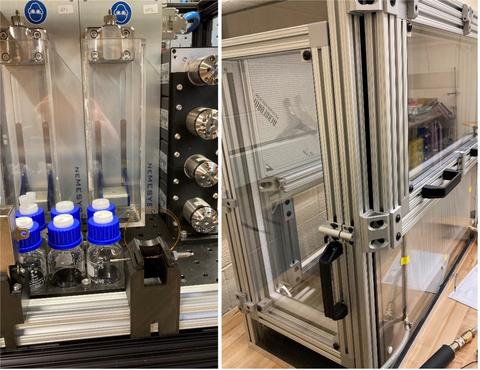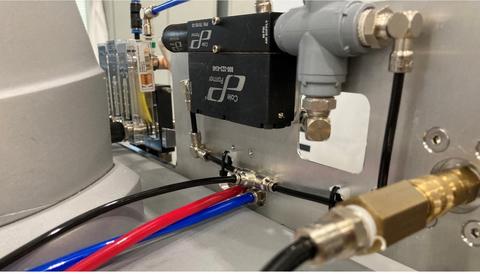CHRNS: Rheometers and Shear Cells
| Instrument | Upgrades (completed) | Upgrades (in progress) |
| Capillary RheoSANS |
|
|
| Rheometer MCR 301/501 |
|
|
Rheometer ARES G2 (see non-equilibrium initiative for details) |
|
|
1-2 Shear Cell (see non-equilibrium initiative for details) |
|
|
Capillary RheoSANS
Originally developed with nSoft, Capillary RheoSANS (CRSANS) provides users access to shear rates up to 106 s-1, which is three orders of magnitude higher than shear rates achieved with a standard Couette cell rheometer [1].
CHRNS has upgraded this system by implementing temperature control from 10 °C to 50 °C, which includes all equipment and tubing in contact with the sample. CHRNS has also integrated high-pressure switch valves and flow selector valves, as well as a software-controlled procedure, to enable easier sample loading, system priming, and air purging.

Ongoing work aims to further improve sample handling by introducing automated cell rinsing and sample changing, as well as to integrate direct rheometer control and rheology data monitoring through the NICE control interface.
Rheometer MCR 301/501
The MCR 301 and 501 rheometers are commonly used instruments for RheoSANS, as they provide a large scattering volume and enable scattering measurements of the 1-3 shear planes (velocity-vorticity) and 2-3 shear planes (gradient-vorticity). These stress-controlled rheometers can measure properties across a broad range of shear rates from approximately 10-3 s-1 to 103 s-1 for most samples.
CHRNS has upgraded this system by implementing a new mounted air manifold with color coded connections and 3-way valves. These upgrades allow for faster and easier equipment swapping between measurements, for example, swapping from the Couette geometry to plate geometry. The new manifolds use a single quick disconnect and are identical for the MCR 301 and 501. This improvement facilitates faster rheometer installation on the beamline, and it enhances the user experience with more consistent and robust sample changes.

Ongoing work aims to improve the alignment of the beam defining aperture, which would allow for more precise SANS measurements and lowered background. It would also significantly reduce the instrument alignment time, providing more time for experimental measurements. Integration of the MCR rheometers with the instrument control software suite and SECOPS is mostly complete. The full integration will allow users to fully control the rheometers from the NICE instrument software and to store all the rheological parameters with the SANS data file.
References
[1] “Capillary RheoSANS: measuring the rheology and nanostructure of complex fluids at high shear rates”, Soft Matter, 16, 6285-6293, DOI: 10.1039/d0sm00941e (2020).


